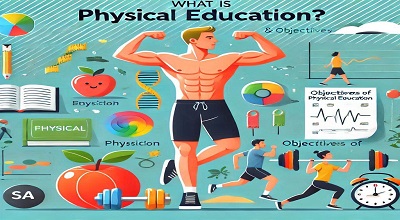Physical Education
Physical Education (PE), also known as phys ed or gym class, is an educational program or curriculum that focuses on the development and improvement of physical fitness and overall well-being through physical activity and exercise. It is an integral part of the broader educational system, with the primary goal of promoting a healthy and active lifestyle among students. Here are some key aspects of what PE encompasses:
- Physical Fitness: Physical education aims to improve and maintain students’ physical fitness. This includes enhancing cardiovascular endurance, muscular strength, flexibility, and body composition. Students engage in various physical activities to achieve these goals.
- Skill Development: PE classes often involve instruction and practice in a wide range of physical activities and sports, such as basketball, soccer, swimming, gymnastics, dance, and more. Students are taught the fundamental skills and techniques required for these activities.
- Health Education: In addition to physical activity, PE often includes instruction on health-related topics. This can encompass lessons on nutrition, the effects of physical activity on the body, the risks of a sedentary lifestyle, and information about substance abuse prevention.
- Wellness Promotion: PE programs promote holistic well-being by emphasizing the importance of maintaining a healthy lifestyle. This includes mental and emotional well-being, stress management, and making healthy choices in all aspects of life.
- Teamwork and Sportsmanship: Many PE activities involve team sports and group activities, which teach students important life skills such as teamwork, cooperation, leadership, and sportsmanship.
More Read….
- Safety: Physical education classes typically include instruction on safety measures to prevent injuries during physical activities. This can involve teaching students proper warm-up and cool-down routines, correct exercise techniques, and knowledge of basic first aid.
- Lifetime Fitness: PE aims to instill a love for physical activity that extends beyond the school years. The goal is to encourage students to adopt and maintain an active and healthy lifestyle throughout their lives.
- Assessment and Goal Setting: PE programs often assess students’ physical fitness levels and provide opportunities for setting personal fitness goals. This helps students track their progress and motivation to improve their physical abilities.
- Adaptation and Inclusion: Physical education should be inclusive and adaptable to accommodate students with various physical abilities and needs. Teachers often modify activities to ensure that all students can participate and benefit from the program.
- Cultural and Historical Awareness: PE may introduce students to the cultural and historical aspects of various physical activities and sports, broadening their understanding of different cultures and traditions.
Physical education is typically a required part of the curriculum in schools, and the specific content and objectives can vary from one educational institution to another. The overall aim, however, is to foster a lifelong commitment to physical activity and overall well-being among students. It helps them develop healthy habits, improve physical fitness, and gain knowledge about maintaining a healthy lifestyle.
Objectives Of Physical Education
The objectives of physical education can vary depending on the educational system, the age of the students, and the specific goals of the program. However, there are several common objectives that are generally associated with PE:
- Physical Fitness: One of the primary objectives of physical education is to promote physical fitness and well-being among students. This includes improving cardiovascular endurance, muscular strength, flexibility, and overall physical health.
- Skill Development: Physical education aims to teach students a variety of physical skills and activities. These may include sports, dance, gymnastics, swimming, and other forms of physical movement. The goal is to help students develop competence and confidence in these activities.
- Health Education: Physical education often includes instruction on topics related to health and wellness. This can include information on nutrition, exercise physiology, the effects of drugs and alcohol, and other health-related topics.
- Motor Development: For younger students, physical education focuses on developing basic motor skills, such as running, jumping, throwing, and catching. These skills are essential for physical development and can provide a foundation for more advanced activities later in life.
- Teamwork and Cooperation: Many physical education activities involve team sports and group activities. These experiences can teach students important lessons about teamwork, cooperation, and sportsmanship.
- Lifetime Fitness: Physical education should instill a love for physical activity that extends beyond the school years. The objective is to encourage students to engage in lifelong physical fitness and recreational activities.
Extra objectives…
- Personal Responsibility: PE can help students develop a sense of personal responsibility for their health and well-being. This includes understanding the importance of regular exercise, making healthy choices, and taking care of their bodies.
- Stress Reduction: Physical activity is known to reduce stress and improve mental well-being. Physical education can provide students with an outlet for stress and help them develop strategies for managing stress through physical activity.
- Social Interaction: Through group activities and team sports, PE provides opportunities for social interaction and the development of social skills. Students learn how to communicate, collaborate, and resolve conflicts in a physical context.
- Cultural and Historical Awareness: Physical education may also introduce students to the cultural and historical aspects of various physical activities and sports. This can help broaden their understanding of different cultures and traditions.
- Safety: Teaching students how to engage in physical activities safely is another important objective. This includes proper warm-up and cool-down routines, injury prevention techniques, and knowledge of first aid.
- Assessment and Goal Setting: Physical education often involves assessing students’ physical fitness levels and helping them set goals for improvement. This can motivate students to work towards achieving their personal fitness objectives.
These objectives highlight the multifaceted nature of physical education, which goes beyond merely promoting physical fitness to encompass broader aspects of health, well-being, and personal development. The specific objectives may vary from one educational institution to another, but the overall goal is to promote a healthy and active lifestyle among students.
